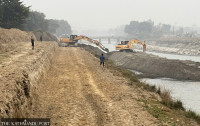National
Covid-19 leaves devastating impacts on education, jobs and mental well-being of youths
ILO study says that the Covid-19 has disrupted the education of more than 70 per cent of youth, leaving a disproportionate effect on young people.
Chandan Kumar Mandal
If it were not for Covid-19 pandemic, Ankita Bhetwal would have been applying for her visa for Canada, and teaching her students English in Kathmandu.
“I would have been happily shopping and hanging out with friends as I would be leaving for Canada in early September to start college,” said Bhetwal, 24, who lives in Thimi, Bhaktapur.
But her plans she charted out so well a few months ago are unravelling. She now feels stranded at home due to the pandemic.
“I had to turn my plans completely upside down,” said Bhetwal, who called off her plans to move to Canada and got admitted at a college in Kathmandu. To make things worse for her, she had to attend a virtual orientation programme organised by her college where she decided to pursue her MBA. “How do we get to know our classmates through the computer screen? I don’t think the whole learning environment is going to be the same,” she said.
Bhetwal is one of the millions of youngsters around the world whose study and job prospects have taken a hit due to the global crisis. A new study by the International Labour Organisation, released on the occasion of International Youth Day, Wednesday, concludes that the Covid-19 crisis is unleashing a devastating effect on the education and training of young people around the world.
The UN agency estimates that 70 per cent of youth who study or combine study with work have been adversely affected due to the closure of schools, universities and training centres due to Covid-19.
The report titled, ‘Youth and COVID-19: Impacts on jobs, education, rights and mental well-being,’ says that a 65 per cent of young people its authors surveyed reported having learned less since the beginning of the pandemic because of the transition from the classroom to online and distance learning during the pandemic-induced lockdown.
Half of the participants believed their studies would be delayed and nine per cent thought that they might fail, says the study.
“The pandemic is inflicting multiple shocks on young people. It is not only destroying their jobs and employment prospects, but also disrupting their education and training and having a serious impact on their mental well-being,” said Guy Ryder, director-general of the agency in a statement. “We can’t let this happen.”
The report points out that the situation has been even worse for young people in lower-income countries as they have limited access to the internet, equipment and sometimes space at home, highlighting a large ‘digital divide’ between regions.
The digital divide has also been seen in Nepal where schools remain shut, and online classes for those who can afford them have become the norm. Children from families struggling to make their ends meet due to the effects of the lockdown have no option but to wait out the pandemic.
A large number of Nepali youths have lost their jobs at home and abroad as economies continue to reel under the effects of the crisis.
“The Covid -19 pandemic is a global health crisis, but more than that it is a global economic crisis. Today there are 1.8 billion people in the world between the age of 15 and 35—a quarter of the global population,” said Pradip Pariyar, a youth activist and executive director at Samata Foundation. “This is the largest generation of young people the world has ever seen. This crisis has left millions out of work and, women, the less skilled and the marginalised have been affected the most.”
A UNDP survey published in May showed that three in five employees lost their jobs due to Covid-19 and most of them were youngsters.
According to the ILO report, 38 per cent of youth are uncertain of their future career prospects, with the crisis expected to create more obstacles in the labour market and to lengthen the transition from school to work.
It said that while one in six youth reportedly had to stop work since the beginning of the pandemic, many younger workers are more likely to be employed in highly affected occupations, such as support, services and sales-related work, making them more vulnerable to the economic consequences of the pandemic, said the report. On the other hand, 42 per cent of those who are still employed faced reduced income.
Pariyar, also a former president of Association of Youth Organisations Nepal, a network of 92 youth-led organisations in the country, said, “The pandemic has triggered mental health problems among young people.”
The ILO said that 50 percent of young people it surveyed are possibly living with anxiety or depression, while a further 17 per cent are probably affected by it. An unexpected rise in suicide have also been reported in Nepal since the beginning of the epidemic in the country in March.
“I don’t see any government effort to help its people deal with this crisis,” said Pariyar. “The government should come up with innovative ideas to create jobs.”
Meanwhile, after deciding to postpone her plans to go abroad, at least for now, Bhetwal managed to land a job for which she returned to Kathmandu from Jhapa when the lockdown restrictions were eased. “My job requires me to go to the office for work and doing that is more challenging than I thought,” she said. “Moreover, I don’t drive and I can’t risk travelling in public vehicles. So, I’m clueless about how to retain my job and not get infected.”




 15.12°C Kathmandu
15.12°C Kathmandu















